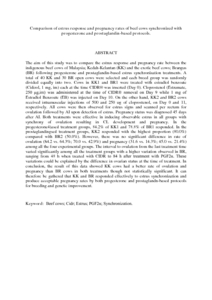Citation
Khumran, A.M. and Yusoff, Rosnina and Omar, Mohamed Ariff and Haron, Abdul Wahid and Dhaliwal, Gurmeet Kaur and Khanh, N.P. and Yap, Chee Kong and M., M. Fahmi and M. E., Azmil
(2012)
Comparison of estrus response and pregnancy rates of beef cows synchronized with progesterone and prostaglandin-based protocols.
Journal of Animal and Veterinary Advances, 11 (19).
pp. 3561-3567.
ISSN 1680-5593; ESSN: 1993-601X
Abstract
The aim of this study was to compare the estrus response and pregnancy rate between the indigenous beef cows of Malaysia; Kedah-Kelantan (KK) and the exotic beef cows; Brangus (BR) following progesterone and prostaglandin-based estrus synchronization treatments. A total of 40 KK and 30 BR open cows were selected and each breed group was randomly divided equally into two. Cows in KK1 and BR1 were treated with estradiol benzoate (Cidirol, 1 mg, im) each at the time CIDR® was inserted (Day 0). Cloprostenol (Estrumate, 250 μg,im) was administered at the time of CIDR® removal on Day 9 while 1 mg of Estradiol Benzoate (EB) was injected on Day 10. On the other hand, KK2 and BR2 cows received intramuscular injections of 500 and 250 ug of cloprostenol, on Day 0 and 11, respectively. All cows were then observed for estrus signs and scanned per rectum for ovulation followed by AI upon detection of estrus. Pregnancy status was diagnosed 45 days after AI. Both treatments were effective in inducing observable estrus in all groups with synchrony of ovulation resulting in CL development and pregnancy. In the progesterone4)ased treatment groups, 84.2% of KK1 and 78.8% of BR1 responded. In the prostaglandingsed treatment groups, KK2 responded with the highest proportion (80.0%) compared with BR2 (50.0%). However, there was no significant difference in rate of ovulation (84.2 vs. 64.3%; 70.0 vs. 42.9%) and pregnancy (31.6 vs. 14.3%; 45.0 vs. 21.4%) among all the four experimental groups. The interval to ovulation from the last treatment time varied significantly among all the treatment groups with a higher variation observed in BR, ranging from 48 h when treated with CIDR to 84 h after treatment with PGF2α. These variations could be explained by the difference in ovarian status at the time of treatment. In conclusion, the result of this data showed KK cows had a better rate of ovulation and pregnancy than BR cows in both treatments though not statistically significant. It can therefore be gathered that KK and BR responded effectively to estrus synchronization and produce acceptable pregnancy rates by both progesterone and prostaglandn-based protocols for breeding and genetic improvement.
Download File
![[img]](http://psasir.upm.edu.my/25944/1.hassmallThumbnailVersion/Comparison%20of%20estrus%20response%20and%20pregnancy%20rates%20of%20beef%20cows%20synchronized%20with%20progesterone%20and%20prostaglandin.pdf)  Preview |
|
PDF (Abstract)
Comparison of estrus response and pregnancy rates of beef cows synchronized with progesterone and prostaglandin.pdf
Download (189kB)
| Preview
|
|
Additional Metadata
Actions (login required)
 |
View Item |

